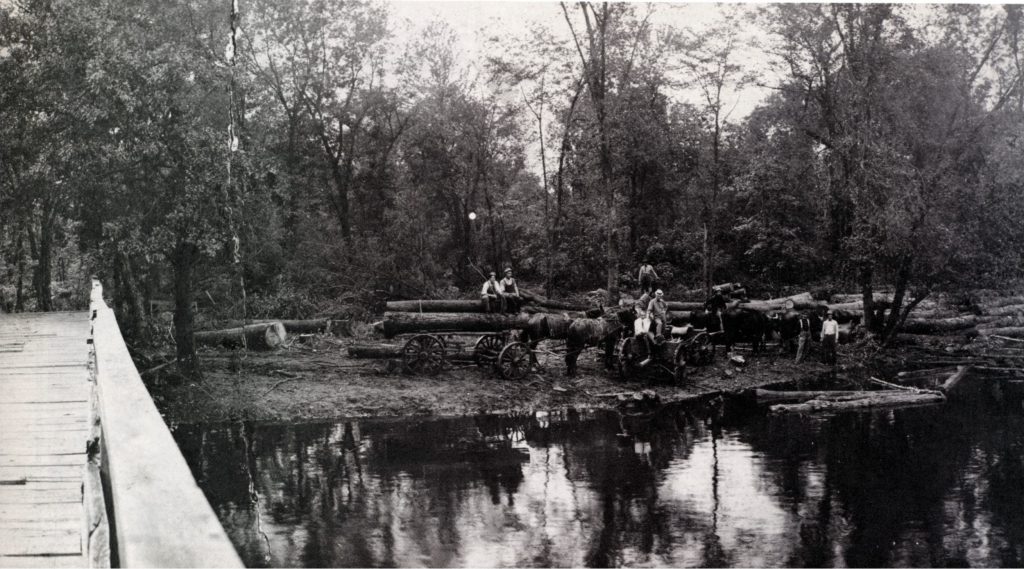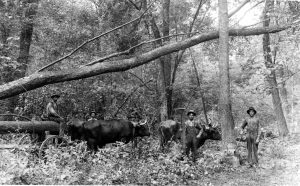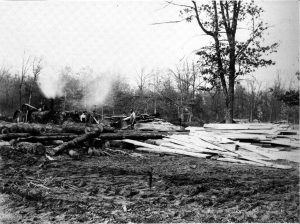Chapter 18
The Tragedy of the Trees
By Fay Folsom Nichols
FEW STORIES that have come out of the river can equal that of the wanton and wasteful slaughter of the trees along its banks. Probably none can surpass the narrative.
Most islands throughout the marshland tracts were covered with heavy timber in various ages and stages of growth. In that particular area that winds along from English Lake south to the State Line, the wooded sections extended back several miles on each side of the stream.
For long years during the winter months, “swamping” was a regular business. Choppers went into the swamps after the first hard freeze. From then on until the spring thaws made it unsafe for men and teams with huge sled loads of logs to cross on the ice, the clang of axe and crash of falling tree echoed the length and breadth of the marshes.
The year’s supply of firewood for all residents for miles around, came out at this time. Rails were split from the white oak to go into long lines of fencing across the farmer’s fields. The use of coal or oil for heating purposes was an unheard of extravagance, and wire fencing yet to come. Many of the more prosperous people of the villages and families in the farming communities without timber on their land, bought small tracts of swamp land, usually from ten to twenty acres, just for the wood upon it.
The buying and selling of chunk and split wood became a major industry. Experienced choppers were paid top wages and dealers were often permitted to take wood from large acreage that the owners of the land might have it cleared for grazing and farming purposes. Business boomed.
Before daylight on cold winter mornings, all roads leading to the swamps would be lined with men and teams, many of them coming great distances. The men would be as warmly dressed as possible in heavy woolen clothing. Their feet would be encased in felt boots inside rubber ones. Then, wrapped in heavy blankets or old patch-work comforters, they would ride the front runners of the empty bob sleds, the sharp-shod teams trotting briskly along in sub-zero temperatures. Each swamper was anxious to be at the timber line by daybreak.
During the day teamsters would haul several loads of logs across the ice to the landings-places at the edge of the marshes, where they would pile them to be hauled out later. Usually swampers respected the rights of others and these piles of wood would be quite safe until the rightful owner had time to haul them home.
Each evening a teamster would bring out as much wood as he could possibly pile onto the runners of his sled, with tall wooden stakes set to hold the now priceless hardwood. Teams had all they could do to pull the heavy loads. The men walked beside the slowly moving sleds, intermittently swinging their arms as they walked trying to keep warm, or beating mittened hands together to restore circulation in cold-stiffening fingers.
On the Hebron road, alone, as many as one hundred sled loads of cut and trimmed trees, slowly moving toward town as one great procession, was a common evening sight. Parallel roads presented the same picture.
By February, particularly if there had been a January thaw, everyone was hoping the groundhog would see his shadow and scuttle back into his burrow for another six-week snooze. Plenty of freezing weather and snow assured a big woodpile.
Neighbor exchanged work with neighbor, and exciting the day when the sawyer arrived with his traction engine and buzzsaw. Then the great piles of cut timber that had been growing in a corner of the wood-lot, would be attacked. By night it had been converted into a greater pile of chunk wood.
Later the larger chunks were sorted out for the large, round-bellied heaters and parlor stoves. The smaller pieces were split into slick, shining sticks for the cook stove. Picking up chips and bark became the job of the youngsters whether they liked it or not. For chips were kindling that hastened the boiling of father’s breakfast coffee, and brought the big pancake griddle to the baking point in double quick time.
Avaricious and thoughtless men were the direct cause of the depletion of this timber. From the very beginning of the white man’s settlement, no one gave thought or heed to future wood and lumber needs, nor to its conservation. Those who did were ridiculed and derided.
Why wood here would last out several generations! They’d never be able to use up all the timber along the Riverl Silly of anyone to entertain such a thought!
But fierce fall fires became a strong contributing factor toward depletion, and with heedless chopping, there was quick and sure exhaustion.
Lumbering could not be thought of as a river industry—at least not a lasting one. True, many of the trees felled were so large that only with the greatest of effort on the part of several sturdy woodsmen, could they be rolled upon and chained to low sled runners. These were sawed into bridge planking, and the roughest of sills and flooring for barns and other farm buildings. Finishing lumber for homes, churches and schools was “imported” from the great lumbering regions of Michigan, Wisconsin and Minnesota.
In 1866 the Indian Island Saw Mill company was formed, with a group of south Porter county men taking stock at $100 per share.
During the winter, when everything was frozen, they moved in their equipment and sawmill, and a master boat builder went about his business of building heavy scows thirty feet long and ten feet wide.
By spring the company was all set to operate and enough trees had been felled that work started in earnest. But they were faced with a problem-how to get the big scows up to the island. Finally, a canal fifteen feet wide and three deep was dug, extending from the island into the River.
The sawed lumber and cordwood was to be taken down the stream as far as Momence, unloaded enroute wherever there was a demand for it. But moving the barges, each loaded with seventy-five cords of wood, was no easy job, even for the hardiest of men. So within two years two of the heaviest stockholders had built and launched The White Star, said to have been the first steamboat on the River.
Her engine did double duty. It supplied the power for the saws set up at the edge of the island and took the scows of lumber and wood downstream.
The White Star’s maiden voyage was a great success, and her huge paddle wheel threw water in tune to the men’s cheers. For several trips the little steamer pulled the barges, but this wasn’t working so well. They were continually sticking to the numerous sand bars, or alternately bumping into the sides of the mucky banks. Some one hit upon the idea of pushing the scows, with men riding the prow and steering with long poles. In this manner the down journeys were made with a minimum amount of trouble.
It took a day and a half to make the trip to Momence. With the building of the Monon railroad bridge across the River near Shelby, this business had to be abandoned because The White Star could not go under the bridge. Anyway, the timber was well cut over, and the lumber and wood business dwindling, so the steamer was sold to Momence men and put on the lower Kankakee as a pleasure boat.
2. THE GREAT SLAUGHTER
The story of buying and selling of hundreds of acres of swamp land, of land speculators and swindlers, is a long and complicated one. Many an Eastern speculator bought entire sections, sight-unseen. Many a small investor purchased less. All found themselves owners of water-covered land which might never produce more than muskrat houses and cattails. Usually, when the buyer discovered his predicament, he checked it up to experience and let his holdings revert to the state in unpaid taxes.
The real slaughter of the trees began in 1907. A Chicago furniture manufacturing company bought up all available standing timber on these lands with plans to have it taken down the river to Water Valley and there loaded on flat cars for shipment to Chicago.
Here were no scrub oak. Tall, big-bodied hardwoods crowned the islands and crowded the river’s banks. The Chicago firm tackled the job in a big way. In the shortest possible time trees were to become board feet in drying kilns.
The manager, spurning advice and help of local men who knew the nature of the swamp-the whims of the Kankakee—brought in “experienced” woodsmen from Kentucky. The Kentuckians arrived almost overnight, bringing with them seasoned oxen and low-swung axles on sturdy logging wagons. Never before had such an industry come to the riverl Excitement ran highl
Scorers marked the treesl Under the axes and crosscut saws, as powerful woodsmen buried them into the trees, great white and red oaks began to fall. Giant yellow poplars, smooth, big-bodied beech and lacy elms were downed. The shining, gray-green trunks of beautiful sycamores lay naked and stripped of their branches. White birch that had struggled to reach the sunlight among close-crowding ash and maples suffered the penalty of having grown tall and straight.
The noise of the men and their labors carried out over the countryside. People came from miles around to witness the slaughter, to clasp their hands and to weep at the absolute destruction of that which they had enjoyed and admired for years.
Oxen bellowed as they struggled through the miry sloughs. Trees spread out their rooty toes as though to stop or hold back the carnage. Bullwhackers cursed and “gee-hawed,” goading the stubborn brutes to the water’s edge. Their rod-long shots of tobacco juice floated down stream with the gurgle from jugs of Kentucky “moonshine.”
The steersmen brought from Kentucky were supposed to be master craftsmen in the art of log rafting. But they had served apprenticeship in the swift, rock-bottomed streams and rivers of their native state. They couldn’t bargain with the twists and turns of the Kankakee, its sand bars and unpredictable bayous.
Their rafts were clumsy contraptions, with too many heavy logs to float well. The elm and the oak were sinkers. Instead of laying them with the stream, using plenty of floaters such as ash, maple and birch, the rafts were fashioned in the opposite manner.
Cribbing the logs meant tying sixteen logs together. Forty cribs made a raft.
The steersmen encountered their first trouble at Windy Bend, a turn not far from Baum’s Bridge. If the wind arose suddenly, as it sometimes does along the River, no matter how strong the language, nor handy the piker was with his peavey (an iron pointed lever with an iron hook on the other end) the raft usually upended here, and was gradually sucked into the greedy sand below the water.
Other as troublesome sand bars presented themselves, and proved a menace the entire distance to Water Valley. These conditions, unexpected and overwhelming, most of which the Kentuckian was unable to cope with, were proving a costly adventure to the furniture manufacturers.
In desperation local rivermen were consulted, and big bosses listened. Rafts were rebuilt, with the heavier logs laid with the stream, and more floaters added to each raft. Two rafts were chained, end for end, for the down journey. Thus, when the first raft struck a sand bar, the second was swung sharply across with the swift current. This jerked the first raft off, setting it again in motion downstream.
These local men knew the vagaries of a temperamental river. If the wind fouled when they attempted to negotiate Windy Bend, they “snubbed” the raft until weather settled. (Snubbing meant tying up to trees along the banks with ropes.)
Only a small percentage of the trees cut ever reached Water Valley and Chicago. Today, millions of feet of the finest of hardwood lie strewn along the river for a distance of over twenty miles. They are buried under sand and river slime to a depth of from twenty to thirty feet. Rivermen claim that logs do not rot under water and sand, and that this timber, if raised, would still be in a fine state of preservation.
Industry moves a land. But the denuding of the marshes was one business not welcomed or appreciated by those who for years had watched the soft green of spring budding the brilliance of fall colorings. What were things coming to!







